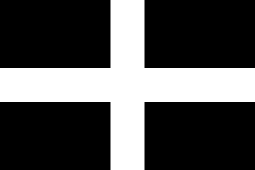Knocker (folklore)
The Knocker, Knacker, Bwca (Welsh), Bucca (Cornish) or Tommyknocker (US) is a mythical human-like creature in Welsh, Cornish and Devon folklore. It is closely related to the Irish leprechaun or clurichaun, Kentish kloker and the English and Scottish brownie. The Cornish described the creature as a little person two feet tall, with a disproportionately large head, long arms, wrinkled skin, and white whiskers. It wears a tiny version of standard miner's garb and commits random mischief, such as stealing miners' unattended tools and food.
| Grouping | Mythological creature Fairy Sprite |
|---|---|
| Other name(s) | Knacker Tommyknocker |
| Country | Britain |
| Region | Cornwall and Devon |
Cornish folklore
The name comes from the knocking on the mine walls that happens just before cave-ins – actually the creaking of earth and timbers before giving way. To some miners, knockers were malevolent spirits and the knocking was the sound of them hammering at walls and supports to cause the cave-in. To others, who saw them as essentially well-meaning practical jokers, the knocking was their way of warning the miners that a life-threatening collapse was imminent.
According to some Cornish folklore, the Knockers were the helpful spirits of people who had died in previous accidents in the many tin mines in the county, warning the miners of impending danger. To give thanks for the warnings, and to avoid future peril, the miners cast the last bite of their tasty pasties into the mines for the Knockers.[1]
In the United States
In the 1820s, immigrant Welsh and Cornish miners brought tales of the tommyknockers[2] and their theft of unwatched items and warning knocks to western Pennsylvania, when they gravitated there to work in the mines. Cornish miners, much sought after in the years following the gold and silver rushes, brought them to Colorado, Nevada, and California.[3] When asked if they had relatives who would come to work the mines, the Cornish miners always said something along the lines of "Well, me cousin Jack over in Cornwall wouldst come, could ye pay ’is boat ride", and so came to be called Cousin Jacks.[4] The Cousin Jacks, as notorious for losing tools as they were for diving out of shafts just before they collapsed, attributed this to their diminutive friends and refused to enter new mines until assured by the management that the knockers were already on duty. Even non-Cornish miners, who worked deep in the earth where the noisy support timbers creaked and groaned, came to believe in the Tommyknockers.[5] The American interpretation of knockers seemed to be more ghostly than elvish.[6][7]
Belief in the knockers in America remained well into the 20th century. When one large mine closed in 1956 and the owners sealed the entrance, fourth, fifth, and sixth generation Cousin Jacks circulated a petition calling on the mineowners to set the knockers free so that they could move on to other mines. The owners complied.[8] Belief among Nevadan miners persisted amongst its miners as late as the 1930s.[7]
Tommyknocker Brewery in Idaho Springs, Colorado owes its namesake to the mythical creature, and began serving in 1859 to meet the needs of the large number of prospectors, as part of the Colorado Silver Boom. The brewery continues to operate and distributes nationally.
Knocker also appeared as a name for the same phenomena, in the folklore of Staffordshire miners.
In literature
- Knockers are a motif found in the science fiction/horror book The Tommyknockers by Stephen King.[9]
- Tommyknockers are also mentioned in the Hardy Boys book, Hunting for Hidden Gold. "Tommy-clockers" is the title of chapter eight.[10]
- A benevolent knocker appears in "The Ironwood Tree", the fourth book in The Spiderwick Chronicles, in which it helps the protagonists escape from a dwarf kingdom.
- In the Pulitzer Prize-winning novel "Angle of Repose" by Wallace Stegner, protagonist Susan Burling Ward first hears about tommyknockers when her husband and his colleagues take her into one of the quicksilver mines at New Almaden.
See also
References
- "Cornish Pasty". Atlas Obscura. Retrieved 2019-01-01.
- Offut, Jason (2019). Chasing American Monsters. Woodbury, Minnesota: Llewellyn Publications. pp. 244–245. ISBN 978-0-7387-5995-1.
- "Cousin Jacks & Tommyknockers". edcgov.us. Archived from the original on 2015-02-11. Retrieved 2015-02-11.
- http://www.clan.lib.nv.us/content.asp?id=441%5B%5D
- "Tommyknockers, Ghosts and Other Legends of the Comstock". 12 October 2007.
- "Tommyknockers - ONE". www.onlinenevada.org.
- "Cousin Jacks & Tommyknockers". edcgov.us. Archived from the original on 2011-09-30. Retrieved 2011-07-18.
- King, Stephen. The Tommyknockers. New York: Putnam, 1987.
- Dixon, Franklin W. Hunting for Hidden Gold. New York: Grosset & Dunlap, 1928.
- Katharine Briggs, An Encyclopedia of Fairies, Hobgoblins, Brownies, Bogies, and Other Supernatural Creatures, "Knockers", p. 254 ISBN 0-394-73467-X.
